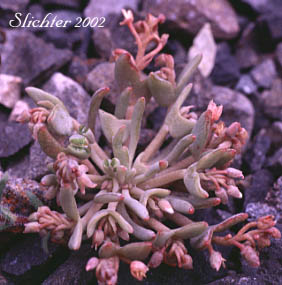 Pale montia as seen from Stacker Butte, Columbia Hills, Columbia
River Gorge, Washington...............April, 2002.
Pale montia as seen from Stacker Butte, Columbia Hills, Columbia
River Gorge, Washington...............April, 2002.
Pale montia is a small, glaucous annual with one to several simple, erect stems from 10-60 cm long. The numerous basal leaves are linear to linear-spatulate, measuring from 2-6 cm long and 0.5-1.5 mm wide. The two stem leaves are opposite, wider and larger than the basal leaves. They are linear-lanceolate to lanceolate-ovate in shape and measure from 5-40 mm long. As seen from the photos, the stem leaves can appear somewhat similar in appearance to the claw of a crab.
The racemes measure from 5-20 mm long. The 2-7 flowers are whitish to pink in color, with the 2 sepals 1-2 mm long and the petals from 2.5-4.5 mm long.
Pale montia is found on seasonally moist to dry soils in the lowlands.
Pale montia may be found from southern British California south along the western edge of the Washington Cascades to the Columbia River, and south along both sides of the Oregon Cascades to southern California.
